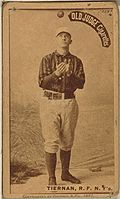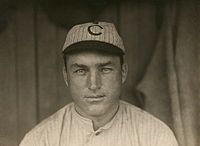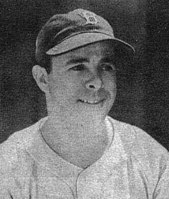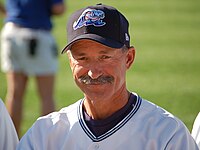Chambersburg Maroons
| Chambersburg Maroons | |||||
|---|---|---|---|---|---|
| |||||
| Information | |||||
| League | West Shore Twilight Baseball League (2004–2010) | ||||
| Location | Chambersburg, Pennsylvania (1895–2010) | ||||
| Ballpark | Henninger Field (1895–2010) | ||||
| Founded | 1895 | ||||
| League championships |
| ||||
| Former name(s) | Chambersburg Young Yanks (1929–1930) Cumberland Colts (1917) | ||||
| Former league(s) |
| ||||
| Colors | Maroon, Grey, Black, White | ||||
| Ownership | Steve Patterson | ||||
| Management | Steve Patterson (GM) | ||||
| Manager | Steve Patterson
| ||||
| Website | Chambersburg Maroons | ||||
The Chambersburg Maroons were a baseball team located in Chambersburg, Pennsylvania. They called historic Henninger Field their home, and had done so since the club's creation in 1895. They played their last season in 2010, ending 116 years of existence.[1]
History
[edit]Early years
[edit]Baseball has been in Chambersburg since the late nineteenth century. On May 16, 1883, a portable dynamo and six 2,000-watt candle lamps were placed on a railcar by the Cumberland Valley Railroad at a cost of $2,753.75. The apparatus was given its first trial run at a night baseball game between George Pensinger's railroad team and Henninger's club from Chambersburg. Many consider this to be the first night baseball game ever played.[2]
A Chambersburg team was part of the Keystone Association which played for one season in 1884. The team, which had no nickname, was managed by Oliver Chambers and finished with a record of 8 wins and 10 losses, 6.5 games behind the first place Lancaster Red Stockings.[3]
Cumberland Valley League
[edit]
The Maroons were created in 1895 by local businessman Clay "Pop" Henninger, who ran a thriving hat shop in Chambersburg.[4] They began play at Wolf Park, the same location throughout their entire tenure. The Maroons were charter members of the Cumberland Valley League, an independent minor league,[5] and won the first league title in 1895.[6] In the following season, the Maroons finish in second place in the league, boasting a 22–14 record. The 1896 Maroons squad boasted a total of seven future Major League Players.
Following the 1900 Season, the Maroons left the Cumberland Valley League to join the Industrial League.
Blue Ridge League
[edit]1915
[edit]
After the 1914 season, the Maroons join the newly formed Class D Blue Ridge League in 1915. The Maroons gain instant credibility when former Major League Player Gus Dorner took the managerial position of his hometown team. James "Bugs" Snyder led the league in hits with 50. Pitcher Ed Stricker had an outstanding season, leading the league with 170 strikeouts. Stricker also threw a no hitter against the Gettysburg Patriots on August 3, winning 1-0. Stricker and catcher George Stroh (who played part of the season with the Hanover Hornets) were selected to the Blue Ridge League End of Season All-Star Team. However, the Maroons struggled through two subsequent managerial changes that season and finished last in the league.[7] Carl Snavely, a member of the 1915 team, would later rise to prominence as a college football coach.[8]
1916 Championship Season
[edit]In 1916, the Maroons brought in a new manager in Eddie Hooper. The Maroons club president, named Kottcamp, worked out a deal with Jack Dunn's Baltimore Orioles, who had returned to the International League, after the demise of the Federal League during the off-season. Two pitchers, Hank Thormahlen and Al Ehmling, and a catcher named Alex Schaufele joined the Maroons, along with a former Federal League player, first baseman Karl Kolseth, and outfielder James "Bugs" Snyder to combine for one of the strongest overall teams in the league in 1916.[9] Hanson Horsey is also showcased on the squad's roster.
The end result would see Chambersburg take the league crown in 1916, with Hooper edging Frederick's Clyde Barnhart for the league batting title (.332). Hooper also led the league with 113 hits. The Maroons' pennant did not come easy, as the Martinsburg Mountaineers battled with the Maroons for first place throughout the season. Despite finishing the season with more wins than another Blue Ridge League team, Martinsburg had to settle for second for the second straight season, this time by just one-tenth of a percentage point. The Maroons finished the season with a record of 53–40–4.[10] A low point in the otherwise tremendous season was the no-hitter tossed by the Hagerstown Terrier's pitcher Wick Winslow on June 28, defeating the Maroons 4-0.[11]
1917
[edit]The 1917 squad was a far cry from the 1916 championship team, and finished with a measly record of 36-63, good for last place in the Blue Ridge League.[12] The Maroons refused to pay a $450 forfeit fee for the league, and things started to go downhill from there. The Maroons were plagued by injuries in the 1917 season, most notably to first baseman Karl Kolseth. Kolseth, the most feared hitter in the league at the time, broke his leg sliding into second base during the first week of the season, and was out for the remainder of the season. The Maroons also suffered from being at odds with fans, one of the local newspapers, and club directors. On June 30, Blue Ridge League President James Vincent Jameson, Jr. awarded the franchise to Colonel Rusler of Cumberland. After two games on the road, the franchise was renamed the Cumberland Colts. Manager Eddie Hooper refused to report to Cumberland and resigned in protest, along with several players. He was replaced by player/coach Brook Crist. The move to Cumberland created some problems for the team. Allegheny County, Maryland, where Cumberland is located, had no "blue laws" prohibiting play on Sundays. The Colts played many games on Sunday drawing large crowds, but antagonizing other teams in the league. Another challenge was transportation. With the roads of the time, it required almost eight hours of time to drive from Gettysburg, Pennsylvania, to Cumberland. This meant teams had to plan overnight stays which increased club expenses.[13] Among the players on the 1917 team was Ivan "Pete" Bigler. Bigler would eventually become the head football and basketball coach at Worcester Polytechnic Institute (WPI) and was enshrined in the WPI Athletic Hall of Fame in 1984.
1918 and 1919
[edit]World War I affected the Blue Ridge League and Chambersburg. Wolf Field, the home field of the Maroons, was plowed up and converted to agricultural purposes. Without a home field and with the war demands for soldiers, the Maroons were unable to field a team in 1918 in the Blue Ridge League. The effects of the war, the flu epidemic that raged throughout the country the latter part of 1918, and the limited resources and finances of the remaining league towns, kept the Blue Ridge League from returning in 1919, which was a boom to the area Industrial Leagues and independent teams.[14]
1920
[edit]The Maroons returned to the Blue Ridge League in 1920, and finished with a record of 38-56.[15] Maroons player Bill Satterlee led the Blue Ridge League with a .355 batting average and 122 hits, turning in a stellar season for the Maroons. Wolf Park was renamed Henninger Field in honor of baseball entrepreneur Clay Henninger.
1921
[edit]In 1921, the Maroons had a record of 46-52, finishing 13 games behind Frederick. Among the outstanding players were Bill Satterlee, who led the league with 31 doubles; and Mike Fuhrey, who topped the league with 31 sacrifice hits. Players selected for the Blue Ridge League End of Season All Star Team were right-handed pitcher Charles Raab, catcher Marion "Jack" Staylor, shortstop Mike Fuhrey and outfielder Charles "Dutch" Mullen.[16]
1922
[edit]The 1922 season was only slightly better than the 1921 season, with a record of 46 wins and 49 losses. George Thomas led all Blue Ridge League second basemen with a .977 fielding average.[17] Maroons pitcher Andy Ferner tied with Bill King of Frederick for the league lead with 228 innings pitched. Right handed pitcher Mike Dowell and catcher Lawrence Steinbach were 1922 Blue Ridge League End of Season All-Star Team selections.[18]
1923–1926
[edit]The Maroons continued their losing ways during this period, never finishing better than 13 games behind the first place team. There were also managerial changes, with different managers in each of the four years. Among the few high points was Leroy Byham leading the league with 16 wins in 1924. That same year George Thomas led the league in runs scored with 89.[19]
1927 Championship Season
[edit]The franchise's fortunes changed in 1927. Chambersburg captured the first half title under manager Mickey Keliher. They also finished first overall in the league, with an impressive 65-34 record. Charles Hamel led the league with 87 runs scored. Pitcher Lester Shatzer led the league in wins and winning percentage (16-2, .888). Unlike 1916, where the Maroons were awarded the championship based on the best overall season record, the Maroons would have to compete in a championship series against the Martinsburg Blue Sox. The Maroons prevailed over the Blue Sox, two games to none. Another change from 1916 was the establishment of an inter-league series between the champions of the Blue Ridge League and the champions of the Eastern Shore League. This series was called the Five State Championship. In this series the Chambersburg Maroons lost to the Eastern Shore Parksley Spuds four games to two. 7,000 fans attended the Five State Championship.
1928
[edit]The Maroons won the second half championship, earning the right to challenge first half champion Hanover Raiders. The Raiders prevailed in the championship series, four games won to one game lost. Pitcher Sheriff Blake led all league pitchers with 17 wins and a .773 winning percentage (17-5). William Howser had an 11-3 record for Chambersburg. After the season the Maroons were purchased by the New York Yankees.[20]
1929
[edit]The 1929 team was renamed the Chambersburg Young Yanks to reflect their affiliation with the New York Yankees. Patrick Shea hit a league-topping 17 home runs. On May 31, the Chambersburg and New York teams played an exhibition game at Henniger Field. Although Chambersburg lost 8-1, New York player Babe Ruth thrilled the crowd by hitting a home run, playing first base and even pitching for an inning.[21] Overall, the Maroons finished 15 games behind the overall first place team Martinsburg Blue Sox.
1930 Championship Season
[edit]Chambersburg's last season in the Blue Ridge League proved to be one of their most successful. Individually, Ted Norbert led the league in both runs (99) and home runs (27), while Gene Padburg led all league pitchers with a .786 winning percentage (11-3). Chambersburg won the league championship two games to one over the Waynesboro Red Birds. With the collapse of the Blue Ridge League, Chambersburg would never again field a fully professional baseball team.
| Chambersburg Maroons Blue Ridge League Season Records [22] | ||||||||
|---|---|---|---|---|---|---|---|---|
| Season | Name | Class | Affiliate | Record | Finish | Games Behind | Manager | Post Season |
| 1915 | Chambersburg Maroons | D | – | 28-51 | 6th | 26.5 | Gus Dorner George Stroh Bill Clay |
None |
| 1916 | Chambersburg Maroons | D | – | 53-40 | 1st | – | Ed Hooper | None (League Champions) |
| 1917 | Chambersburg Maroons Cumberland Colts |
D | – | 16-25 20-38 |
6th | 26 | Ed Hooper Brook Crist |
None |
| 1920 | Chambersburg Maroons | D | – | 38-56 | 5th | 17 | Ed Hooper | None |
| 1921 | Chambersburg Maroons | D | – | 46-52 | 5th | 13 | Harry Hinchman | None |
| 1922 | Chambersburg Maroons | D | – | 46-49 | 5th | 10 | Mike Mowrey | Did not qualify |
| 1923 | Chambersburg Maroons | D | – | 41-55 | 4th | 25.5 | Mike Mowrey Wayne Dowell |
Did not qualify |
| 1924 | Chambersburg Maroons | D | – | 47-52 | 3rd | 13 | Frank "Red" McDermott George "Buck" Ramsey |
Did not qualify |
| 1925 | Chambersburg Maroons | D | – | 39-59 | 5th | 25 | Ed Goosetree Patsy O’Rourke John Reistenberg John Hummel |
Did not qualify |
| 1926 | Chambersburg Maroons | D | – | (1st Half) 20-31 (2nd Half) 18-24 |
5th 4th |
18 7.5 |
Alvin Julian Rankin Johnson |
Did not qualify |
| 1927 | Chambersburg Maroons | D | – | (1st Half) 32-18 (2nd Half) 33-16 |
1st 2nd |
– 0.5 |
Mickey Keliher | Defeated Martinsburg 2-0 in Blue Ridge League Championship Lost to Parksley 4-2 in Five State Championship |
| 1928 | Chambersburg Maroons | D | – | (1st Half) 27-22 (2nd Half) 30-15 |
2nd-tie 1st |
4 – |
Mickey Keliher | Lost to Hanover 4-1 in Blue Ridge League Championship |
| 1929 | Chambersburg Young Yanks | D | New York Yankees | (1st Half) 28-29 (2nd Half) 25-32 |
4th 4th |
7.5 13 |
Tom Clarke | Did not qualify |
| 1930 | Chambersburg Young Yanks | D | New York Yankees | (1st Half) 31-24 (2nd Half) 38-20 |
1st-tie 1st |
– – |
Leo Mackey | Defeated Waynesboro 2-1 to win 1st half championship Awarded league title |
Adult Leagues
[edit]The Chambersburg Maroons name lived on in semiprofessional leagues. The Chambersburg Maroons played in a semiprofessional league also called the Blue Ridge League in 1934.[23] In 1935, the Maroons were members of the semiprofessional Cumberland Valley League.
Franklin County Adult League
[edit]The Maroons were members of the Franklin County Adult League (FCAL) from 1936 to 1986. In 1979, the Maroons won the first of their three FCAL championships. In 1983, after struggling early, the Maroons reeled off 28 straight wins and finished with a 31-5 mark. This led to its second FCAL championship, under second-year manager "Dollar Bill" DeMoss. In 1986, Chambersburg won a third FCAL title.
Blue Ridge Adult League
[edit]The Maroons moved to the Blue Ridge Adult League (BRAL) in 1987, playing there through 2003.[2] Outfielder Brian McCrossen was selected to the 2001 BRAL end of season All-League Team. First baseman Tony Ponton, third baseman Aaron Edwards, shortstop Andy Smith and utility player Brian Ramsey were chosen for the 2003 BRAL end of season All-League Team.[24]
West Shore Twilight Baseball League
[edit]In 2004, the Chambersburg Maroons joined the semipro West Shore Twilight Baseball League.[2] The Maroons qualified for the playoffs in 2006, 2009, and 2010. However, they were unsuccessful in their quest to win the playoffs in any of the three years.[25] The team played their last games in the quarterfinals of the league championship in 2010 against the Mechanicsburg Cardinals. The last home game at Henniger Field was played on July 27, 2010, with Chambersburg losing 8-0 to Mechanicsburg. The last game for the franchise was played at Mechanicsburg's Rickenbach/Shirley Field on July 28, 2010, with Chambersburg again losing 6-3.[26]
| Chambersburg Maroons West Shore Twilight Baseball League Season Records | |||||||
|---|---|---|---|---|---|---|---|
| Season | Level | League | Division | Record | Finish | Games Behind | Playoffs |
| 2004 | Semipro | West Shore Twilight Baseball League | – | 5-25 | 5th | 17 | Did Not Quality |
| 2005 | Semipro | West Shore Twilight Baseball League | – | 9-19 | 6th | 15 | Did not qualify |
| 2006 | Semipro | West Shore Twilight Baseball League | – | 20-10 | 2nd | 2 | Lost to Shippensburg Stars 3 games to 1 in semifinals |
| 2007 | Semipro | West Shore Twilight Baseball League | – | 9-21 | 9th | 16.5 | Did not qualify |
| 2008 | Semipro | West Shore Twilight Baseball League | – | 11-20 | 10th | 17 | Did not qualify |
| 2009 | Semipro | West Shore Twilight Baseball League | – | 22-11 | 3rd (tie) | 3 | Defeated Cumberland Dodgers 3 games to 2 in Quarterfinals Lost to Shippensburg Stars 3 games to 2 in semifinals |
| 2010 | Semipro | West Shore Twilight Baseball League | South | 15-15 | 4th | 6.5 | Lost to Mechanicsburg Cardinals 3 games to 0 in quarterfinals |
Major league connections
[edit]Chambersburg Team Players Who Made the Majors
[edit]Mike Mowrey played for and managed the Maroons in the 1922 season, following his playing days with several major league teams. His ventures included a World Series appearance for the Brooklyn Robins in 1916. In 1922, he batted .351 in the 75 games he played. Despite his efforts, Chambersburg finished next to last in the Blue Ridge League, and Mowrey left professional baseball for a quiet life in the town. Mowrey died in 1947 and his memorial service was held at Henninger Field.[27]
Herb Thormahlen also played for the Maroons in 1916 while the club was still a part of the Blue Ridge League. The Maroons pitcher ended playing in the Major Leagues for the New York Yankees (1917–1920), Boston Red Sox (1921), and Brooklyn Robins (1925). Thormahlen's pitching helped lead the Maroons to the 1916 Blue Ridge League pennant.[28]
What follows is a list of Major League Players who have played for Chambersburg by year.[28][29]
| 1921 | 1922 | 1923 | 1926 | 1927 | 1928 | 1929 | 1930 |
|---|---|---|---|---|---|---|---|
| Harry Hinchman | Mike Mowrey | Red McDermott | Rankin Johnson | Mickey Keliher | Mickey Keliher | Dick Barrett | Tom Carey |
| Mike Mowrey | Rusty Saunders | Mike Meola | Vito Tamulis | ||||
| Clay Bryant | |||||||
| Dee Miles |
Area People Associated with Major League Baseball
[edit]In addition to the players on the Chambersburg teams, several other individuals from Franklin County, Pennsylvania, where Chambersburg is located, have connections to Major League Baseball. Among these are:
- Ike Brookens, pitcher with the Detroit Tigers in 1975.
- Jeff Brookens, scout for the Chicago Cubs, Milwaukee Brewers and Cincinnati Reds.[30][31]
- Tom Brookens, third baseman with the Detroit Tigers, New York Yankees and Cleveland Indians.
- Bob Carter, scout for the Los Angeles Dodgers, Kansas City Royals and Baltimore Orioles. Died June 3, 1997.[32]
- Gus Dorner, pitcher with the Boston Beaneaters, Cincinnati Reds and Cleveland Naps from 1902 to 1909.
- John Fierro, trainer for the Philadelphia Phillies and Chicago Cubs.[33]
- Nellie Fox, infielder. Inducted into Baseball's Hall of Fame on August 3, 1997.
- Rube Manning, pitcher for the New York Highlanders from 1907 to 1910.
- Bob Moorhead, pitcher for the New York Mets in 1962 and 1965.
- Jack Mull, coach for the 1985 San Francisco Giants.
- Sam Snider, bullpen catcher for the Baltimore Orioles.[34]
- Piggy Ward, outfielder for the Philadelphia Quakers, Baltimore Orioles, Cincinnati Reds, Washington Senators from 1883 to 1894.
External links
[edit]- Official site of the Chambersburg Maroons
Further reading
[edit]- Johnson, Lloyd and Wolff, Miles, editors: Encyclopedia of Minor League Baseball. Durham, North Carolina Publisher: Baseball America, 2007. Format: Hardback, 767 pp. ISBN 978-1-932391-17-6
- Savitt, Robert B. The Blue Ridge League: Images of Baseball Publisher: Arcadia Publishing, 2011. Format: Softcover, 127pp. Language: English. ISBN 978-0-7385-8239-9
References
[edit]- ^ Gotwals, Ed (18 March 2011). "WEST SHORE BASEBALL: Chambersburg Maroons will not play this season". Chambersburg Public Opinion. Retrieved 5 October 2014.
- ^ a b c "CHAMBERSBURG BASEBALL HISTORY". leaguelineup.com/maroons. Archived from the original on 10 October 2014. Retrieved 6 October 2014.
- ^ Encyclopedia of Minor League Baseball. Baseball America. 2007. p. 142.
- ^ Savitt, Robert (2011), The Blue Ridge League: Images of Baseball, Arcadia Publishing, p. 28
- ^ Baseball-Reference, Cumberland Valley League
- ^ Maroons Website Retrieved 7 july 2024
- ^ Encyclopedia of Minor League Baseball. Baseball America. 2007. p. 259.
- ^ Encyclopedia of Minor League Baseball. Baseball America. 2007. p. 302.
- ^ 1916 Blue Ridge Stummary
- ^ Official 1916 Blue Ridge League Statistics
- ^ Encyclopedia of Minor League Baseball. Baseball America. 2007. p. 265.
- ^ 1917 Blue Ridge League Standings
- ^ Blue Ridge League 1917 Summary
- ^ Ziegler, Mark. "Blue Ridge League - History - 1918". Boys of the Blue Ridge 2014. Retrieved 9 October 2014.
- ^ Blue Ridge 1920 Standings and Statistics
- ^ Ziegler, Mark. "1921 Blue Ridge League Summary" (PDF). Boys of the Blue Ridge 2014. Retrieved 10 October 2014.
- ^ "Complete Blue Ridge League Averages for Season Announced" (PDF). The Daily News. Frederick, Maryland. 16 September 1922. Retrieved 10 October 2014.
- ^ Ziegler, Mark. "1922 Blue Ridge League Summary" (PDF). Boys of the Blue Ridge 2014. Retrieved 10 October 2014.
- ^ Encyclopedia of Minor League Baseball. Baseball America. 2007. p. 294.
- ^ "Blue Ridge League 1928" (PDF). 1929 Spalding Official Baseball Guide. Retrieved 10 October 2014.
- ^ Savitt, Robert (2011), The Blue Ridge League: Images of Baseball, Arcadia Publishing, p. 91
- ^ Savitt, Robert (2011), The Blue Ridge League: Images of Baseball, Arcadia Publishing, pp. 125–127
- ^ "Frederick in Second Place; Blue Sox Retain Blue Ridge League; Moose in Fourth Place", The Daily Mail, Hagerstown, Maryland, June 11, 1934
- ^ "Blue Ridge Adult League All-League Team". leaguelineup.com/bral. Retrieved 12 October 2014.
- ^ "West Shore Twilight Baseball League". leaguelineup.com/westshoretwilightbaseballleague. Archived from the original on 10 October 2014. Retrieved 6 October 2014.
- ^ "Chambersburg Maroons Schedule". leaguelineup.com/maroons. 5 January 2013. Archived from the original on 10 October 2014. Retrieved 6 October 2014.
- ^ Mike Mowrey Biography
- ^ a b Blue Ridge Official Historical Site
- ^ Baseball Reference Maroons History
- ^ "CHAMBERSBURG BASEBALL HISTORY". leaguelineup.com/maroons. Archived from the original on 10 October 2014. Retrieved 13 October 2014.
- ^ Abrogast, Lizi (3 September 2012). "H.S. SPORTS: PIAA honors Jeff Brookens for years of service as official". Public Opinion. Chambersburg, Pennsylvania. Retrieved 13 October 2014.
- ^ "Bob Carter Baseball Statistics". thebaseballcube.com. Retrieved 13 October 2014.
- ^ Gotwals, Ed (29 August 2008). "BASEBALL: Native John Fierro serves as USA baseball team's trainer in Beijing". Public Opinion. Chambersburg, Pennsylvania. Retrieved 13 October 2014.
- ^ "MINOR LEAGUE BASEBALL Sam Snider gets job at York manager". Public Opinion. Chambersburg, Pennsylvania. 7 August 2009. Retrieved 13 October 2014.
- Franklin County, Pennsylvania
- Chambersburg, Pennsylvania
- Amateur baseball teams in Pennsylvania
- Defunct baseball teams in Pennsylvania
- 1895 establishments in Pennsylvania
- 2010 disestablishments in Pennsylvania
- Baseball teams established in 1895
- Baseball teams disestablished in 2010
- Cumberland Valley League teams
- Blue Ridge League teams













